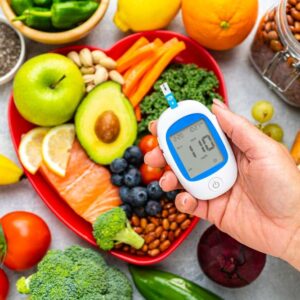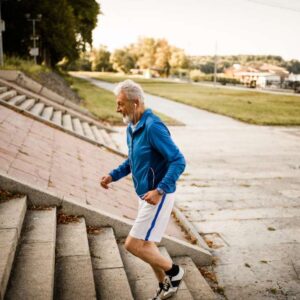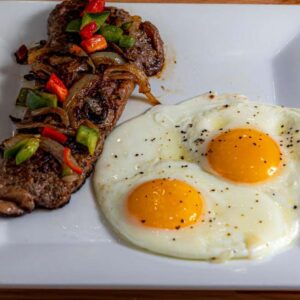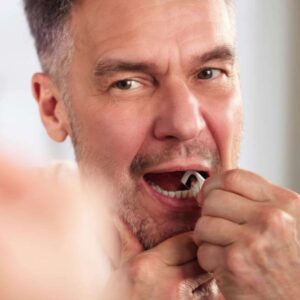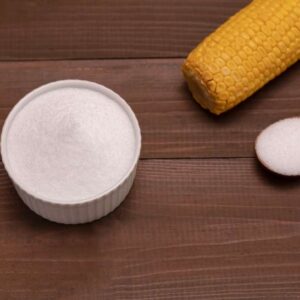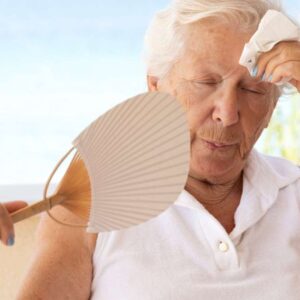
Make This Ancient Hawaiian Gut Healthy Food at Home
Dear Reader,
“Sweet potato pancakes, turkey bacon, egg scrambled with cheese and hash browns, right?”
“Ummm, yeah, that’s it — oh, and ketchup?” I replied.
This wouldn’t be so bad as a once-in-a-while treat, but this is what I was up to two mornings a week.
Who was I kidding? Did I really think that because the words “sweet” and “potato” were in front of the word pancake I was doing my body a favor?
And hasbrowns with KETCHUP?!?
This was a far cry from my typical eggs and fermented beets breakfast.
Not to mention the pizza and pad thai I’d been recently “treating” myself to for dinner a couple nights a week.
Headaches, indigestion, muscle aches, inflammation, brain fog, poor sleep, and a general feelings of imbalance were always for dessert.
The last few months have been pretty hectic for me.
I moved to a new city, started a new job, increased my normal exercise routine, changed my time zone, reset my sleep cycle, and added a new dog to my tiny tribe of pets.
Life is like this sometimes — you get busy or have a lot of change all at once.
And if you are anything like me, your emotions can easily sway your food choices in the wrong direction. Time constraints and reactions to change can rob you of proper meal preparation and cooking.
This means eating a lot of garbage food like the diner breakfast listed above.
Garbage food = carb loaded take out, processed and packaged foods, and foods with little nutritional value.
I know much better than to do this to myself, but I did.
My body paid the price for my convenient and emotionally stimulated bad food choices.
Luckily, I reunited with a food to help me get back on track and I am starting to feel like myself again. I will share more about that in a bit.
I was feeling the biological effects of the garbage foods. The chemicals, sugars, and simple carbohydrates were making me sluggish, dulling my mental edge, and inducing inflammation — even with increased exercise levels!
I had convinced myself it was fine to eat as I pleased because I was putting in more time at the gym. Clearly, I was wrong.
Then, one day when I was feeling particularly bad, I began unpacking some of my many moving boxes. I stumbled upon a notebook from my freshman year Hawaiian Studies class at the University of Hawaii. I had written on the front cover:
I ola no ke kino i ka mā’ona o ka ‘ōpū.
The body enjoys health when the stomach is well filled.
Cue the light bulb — I feel like garbage because I am eating garbage.
A Food Rich in Culture and Nutrition
I always started my day with one food when I was living on the Big Island. Hint: It was not a pancake of any variety.
Considered sacred by many Hawaiians, this food fueled Polynesian warriors, and Hawaiian royalty, and is still a part of today’s diet for many Pacific Islanders. The food is poi, a naturally fermented paste made of cooked taro (kalo in Hawaiian) corms and water.
Poi was the staple food of Hawaiians well into the 20th century. This changed once the islands became a part of the United States and local eating habits became westernized.
In fact, Historical evidence suggest that only after the introduction of the Western diet did natives Hawaiians begin to battle diabetes and heart disease — when native foods like poi were swapped with processed and refined foods. These days, native Hawaiians are getting diabetes at rate three times higher than non-Hispanic whites. 2,3 This is a reflection of how devastating the Western diet can be to good health.
Due to its fiber and complex carbohydrate content, poi is a low glycemic index food and also contains many antioxidants and nutrients, including copper, iron, zinc and magnesium. It has a high potassium level as well, making it helpful in regulation of heart rate and blood pressure functions. 4
Poi is highly digestible — so much so that some Polynesian languages didn’t even have a word for indigestion.1
Poi is a good solutions for people with digestive disorders such as irritable bowel or severe food allergies due to it being a hypoallergenic, probiotic, fermented, and gluten-free food.
And it is easy to make and store.
Naturally Fermented
Adding ferments to your daily diet can aid in digestion by increasing good gut bacteria.
In fact, Dr. David Perlmutter said the following about ferments and good gut health in an interview with Brad Lemley, the guru at Natural Health Solutions:
“Humans have been actively fermenting food for at least 7,000 years…it’s a good way of boosting good bacteria within the body. I recommend eating probiotic, fermented foods throughout the course of the day.” 4
Sidebar: Dr. Perlmutter writes about the importance of diet, consuming fermented foods and gut bacteria in his book Brain Maker. Some of the negative physical effects I was experiencing were likely due to the foods I was consuming negatively affecting my gut bacteria. You can read more of the interview at Brad Lemley’s Natural Health Solutions and a copy of Brain Maker is your free gift with subscription. If you are interested, you can find all of the information here.
If you are familiar with Brain Maker already, poi is a ferment Dr. Perlmutter did not mention in the book but is an easy addition if you’re seeking a convenient homemade source.
Fermentation of poi happens naturally, due to yeast and lactic acid bacteria occurring on the surface of the corm.
Meaning you don’t have to add a starter culture to activate the fermentation process. This provides an easy option for homemade ferments — just make the poi and let nature do its thing.
Cooking the taro corms and then pounding them with the gradual addition of water creates poi. The amount of added water determines the thickness of the paste.
Since poi availability is limited or non-existent in most areas outside of the Hawaiian Islands, the best way to get your hands on it is to make it yourself.
Let me show you how.
Pounding the Poi
Just kidding, I’m not pounding anything.
Traditional poi making requires a pounding stone and board.
I am not opposed to the traditional pounding method. It’s just that I don’t have the equipment.
Chances are you don’t either.
You can get taro corms from Asian markets, and some grocers carry them as well. Or you can order them from Amazon.com like I did.
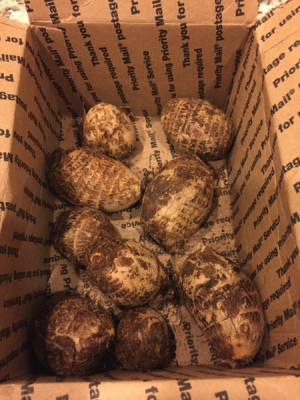
A box full of taro corms delivered to my door.
I typically use three-four roots per batch.
Select the croms you like and rinse them off. And then place them in a pot of boiling water. Boil on medium heat for 40 minutes or until soft when poked with a fork
Warning: Be sure to wash your hands after handling raw corms. Their uncooked skins can cause irritation to your skin. It is very important to boil before you peel.
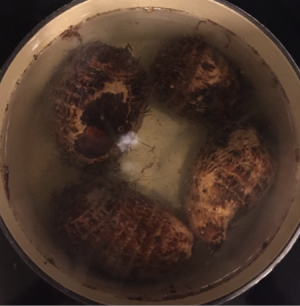
Taro corm hot tub.
Once the corms are soft, drain them in a strainer and allow them to cool for approximately 30 minutes or till cool to touch.
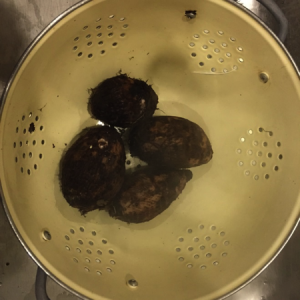
Boiled corms just chilling.
Now it’s time to peel and slice your cooked corms. It is best to do this with a knife versus a vegetable peeler. I usually cut the corm in half and peel off the think skin with my fingertips. I have experienced much success with this method. Once peeled, you can slice the corms into small chunks.
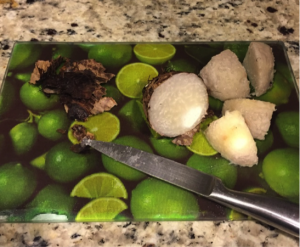
Slicing the corms can be a very sticky experience, so be sure to wipe your hands and knife handle afterward.
Next, place the cooked chunks into a food processor or blender. And add a small bit of water. I usually start with one tablespoon and add more water as I go. Blend until smooth. The consistency is your preference — just add water until you get the thickness you like best.
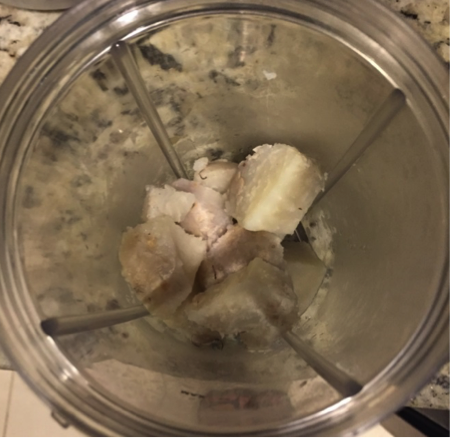
Blend me!
I like my poi pretty thick — think Elmer’s paste. I have to spatula it out into jars.
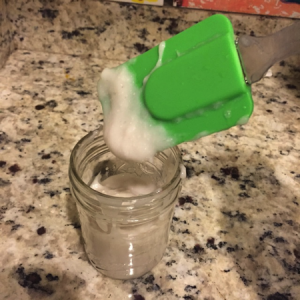
One spatula full at a time.
Lastly, let your poi sit on the counter for one-two days and ferment. If you would rather not enjoy your poi soured, you may eat it immediately. It has a mildly sweet flavor when it’s fresh.
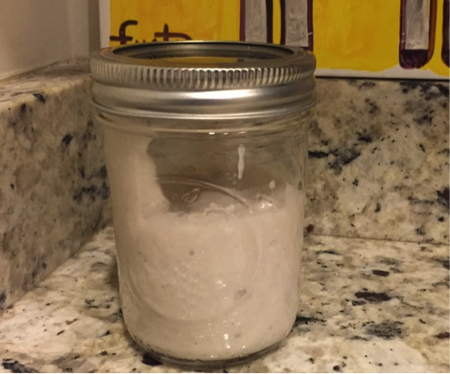
This is the poi made from a single corm.
And there you have it, homemade, starter-free ferments.
After having reduced my garbage food intake and poi for breakfast every morning, I am starting to feel like my old self again — my thoughts are quicker, my mood has lifted and my digestion is back on track.
Since it is a starch, remember to keep your portion size limited but that shouldn’t be an issue as it is very filling. A half a cup in the mornings keeps me going.
If you have any questions or would like to share your poi making experience, write me! nmoore@lfb.org
Live well,

Natalie Moore
Managing editor, Living Well Daily
Citations
[1] Brown AC, Valiere A. The Medicinal Uses of Poi. Nutrition in clinical care : an official publication of Tufts University. 2004;7(2):69-74.
[2]
Pre-European Hawaiian high carb diet trial (paleo) reverses Lupus, obesity and diabetes
[3] Native Hawaiian & Other Pacific Islander Populations
[5] The Secret of Lifelong Brain Power… Is in Your Gut
Written By Natalie Moore
Natalie Moore is a dedicated health researcher with a passion for finding healthy, natural, and science-based solutions. After a decade of direct healthcare experience in western and natural medicine, she was involved in public health research before joining Living Well Daily.
View More Free Articles
Stop Obsessing Over Diet Trends
Can we stop with the endless diet debates already? Every other week there’s a new headline shouting about which diet is best for weight loss, heart health, or diabetes. Paleo, keto, low-carb, high-protein… it’s exhausting. And now, a new meta-analysis is out comparing the Mediterranean diet, the DASH diet, and something called AHEI (that’s “Alternative...
A New Reason to Ditch Processed Junk
If you’ve ever walked the inside aisles of your local grocery store and thought, “This is all just junk,” your instincts were spot on. A new study published in the journal Thorax just added another red flag to the list of dangers linked to ultra-processed food—a 41 percent higher risk of lung cancer. That’s right....
When Being Winded on Stairs Is Serious (And When It Isn’t)
I had an athlete visit me recently because he experienced shortness of breath while climbing stairs. He is in great shape, so he was worried about what it might mean. “Doc,” he said, “I run five miles three times a week. Why am I huffing and puffing after two flights of stairs?” His concern is...
Study EXPOSES Hidden Danger Lurking in Your Car
We think of our homes and cars as safe havens. But according to a startling new study, they may be flooding your lungs with microscopic plastic particles—every single day. Researchers in France recently found that adults inhale an average of 68,000 microplastic particles daily from indoor air alone. To put that in perspective, that’s about...
Mailbag: Is Modern Food Making You Snore?
“What can cause snoring, and is there a way to correct this issue?” —Seeking Silence Hi Seeking, Snoring happens when the soft tissues in your throat relax and vibrate as air passes through during sleep. While several factors can cause snoring—from sleep position to nasal congestion—I want to share one trigger that might surprise you....
Simple Food Swap SLASHES Dementia Risk 28%
Let’s be honest… who would jump at the chance to cut their dementia risk by 28 percent. And no, you don’t need to run marathons, survive on broccoli, or learn to play the zither (whatever that is) to make it happen. All it takes is one easy swap—something that’s probably already in your refrigerator. Researchers...
This SMART Floss Exposes Hidden Health Danger
Scientists have created dental floss that doesn’t just clean between your teeth—it also tracks your stress while you’re flossing. Now, I know what you’re thinking… “Great—now even flossing is going to stress me out by telling me how stressed I am.” But this fascinating new tool from Tufts University could be a game-changer for understanding...
Is This "Safe" Sweetener Damaging Your Brain?
The headlines are alarming… “Popular Sugar Substitute Linked to Brain Cell Damage” and “Erythritol Could Damage Critical Brain Barrier” are just two of the dozens I’ve spotted recently. But before you toss every sugar-free product in your pantry, let’s take a closer look at what this study actually shows—and what it doesn’t. The latest research...
This Summer Threat Could SPIKE Your Blood Sugar
Picture this… It’s another scorching hot summer day. You crank up the air conditioning while watching the weather forecast, which predicts yet another “record-breaking” heat wave. It’s starting to feel like just another miserably uncomfortable summer. But what you might not realize is that—if you have diabetes—those rising temps could do far more damage to...
Move Over Yogurt—5 Foods That Pack MORE Probiotics
Let’s talk about your gut. The microbiome is the collection of trillions of bacteria and other tiny organisms that live in and on your body—especially in your gut—and help keep you healthy. I’ve written often about how vital it is to maintain a healthy microbiome. And you might have dutifully added yogurt to your shopping...
